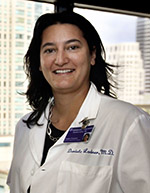
How long patients wait for kidney transplants often depends on where they live. But minor changes to kidney transplant allocation policies could reduce those geographic disparities, suggests a Northwestern Medicine study.
In the United States, there are more than 100,000 patients currently on the waiting list for a kidney transplant. The average waiting time hovers close to five years. In 2011, 17,000 kidney transplants occurred, with 94,000 people remaining on the list.
“Depending on where a patient lives, it might take shorter or longer to receive a kidney organ for transplantation. Despite efforts, this has not improved over the course of 20 years and in most regions this has worsened,” said Daniela Ladner, MD, MPH, assistant professor in Surgery-Organ Transplantation.
In the study, published in the Clinical Journal of the American Society of Nephrology, scientists found that an allocation system called Statewide Sharing significantly decreased geographic disparity between donor service areas (DSAs).
There are 58 DSAs in the United States, divided into 11 regions. The finding applies to two states with multiple DSAs, Florida and Tennessee, which adopted Statewide Sharing in the early 1990s.
“Both states changed their kidney allocation system, such that an available kidney is first offered within the DSA where the organ is procured, then statewide, then within the United Network for Organ Sharing (UNOS) region, which may include several states, and last nationally,” said Dr. Ladner.
Traditionally, kidneys are not distributed statewide before regionally. Doing so improved deceased-donor kidney transplant rates, waiting time to transplantation and other measures of geographic allocation disparity.
Analysis spanning the period from 1987 to 2009 showed inequalities between DSAs in Florida and Tennessee almost completely disappearing after implementing Statewide Sharing. At the same time, disparity did not improve in all nine other states with more than one DSA.
“Increased scrutiny has led to discussions about improvement of geographic disparity in kidney allocation within UNOS,” said Dr. Ladner. “As multiple models are being considered – including sweeping changes to the existing allocation system – this natural history study can provide important information for the discussion. Small changes to the existing model can have a potent effect.”
The study is a result of collaboration that began in 2009 between Northwestern University Feinberg School of Medicine and the McCormick School of Engineering. With Dr. Ladner, Sanjay Mehrotra, PhD, director of the Center for Engineering and Health, John Friedewald, MD, associate professor in Medicine-Nephrology, and then pre-doctoral student Ashley Davis, PhD, worked together through the Northwestern Transplant Outcomes Research Collaborative (NUTORC).
“This work is an example of successful interdisciplinary collaboration through NUTORC. Neither group could have done it alone,” said Dr. Ladner, who is the director of NUTORC. “It required intimate knowledge about information gaps within the field from the transplant clinicians, as well as math and modeling expertise from the engineers.”
The work was funded in part by National Science Foundation award CMMI-1131568 and Agency for Healthcare Research and Quality Health Services Research Dissertation Award R36 HS021078-01 and NUTORC.






